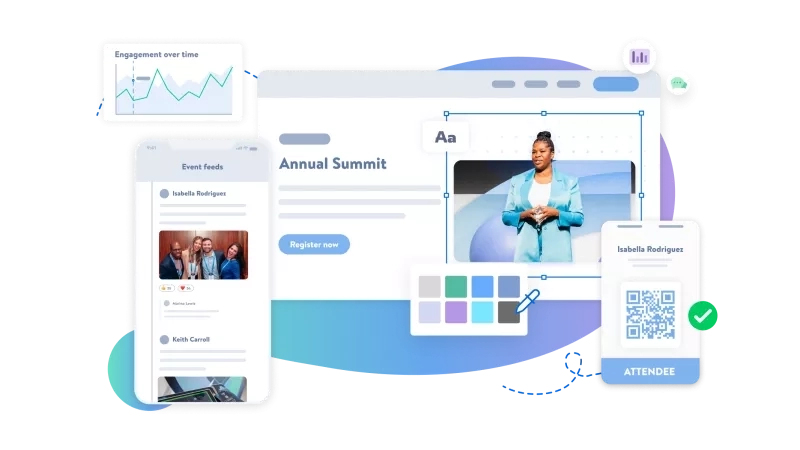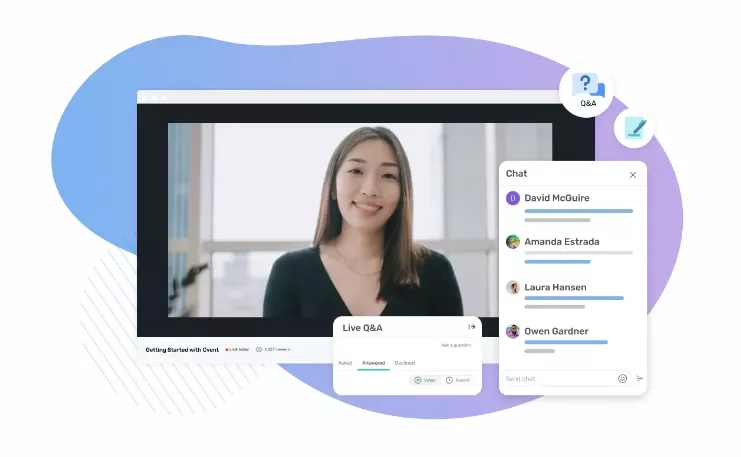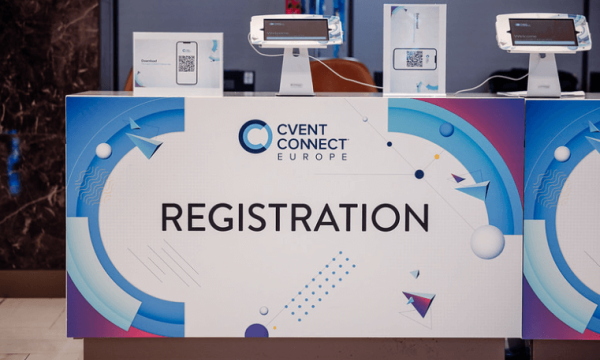Webinars aren't just a fad but a powerful tool for driving conversions. You already knew that. But you might not know how to craft the ultimate webinar funnel that truly converts.
This blog is here to make your webinars work harder and smarter for your business so you can capitalize on all the advantages of hosting a webinar. We’re here to help you understand what a webinar funnel is, and we've outlined a step-by-step process for creating a webinar sales funnel that drives conversions.
What is a webinar funnel?
A webinar funnel is a strategically designed process that guides hot leads through a series of steps, ultimately leading them to convert from prospects to paying customers and, eventually, brand advocates.
What is the webinar funnel process?
Your webinar funnel will includes these five key stages:
- Awareness: This initial stage is about generating interest in your product or service via social media, paid advertisements, and email marketing, enticing people to register for your webinar. Leads at this point are considered top of the funnel (ToFu).
- Engagement: Once someone has registered for your webinar, they enter the engagement stage. Maintain their interest through emails, teasers, or valuable educational materials, transitioning leads from ToFu to the middle of the funnel (MoFu).
- Evaluation: During the webinar, your primary objective is to inform the audience about the benefits and value of your product or service. This is the evaluation stage, where potential customers are assessing the advantages and disadvantages of your offering. They are now at the bottom of the funnel (BoFu).
- Conversion: As the webinar ends, you'll want to usher your audience toward the conversion stage. You can do this by providing additional resources or introducing a special promotion or discount that encourages them to purchase. Even if they don't immediately buy, you can continue to follow up with more resources or future webinar opportunities.
- Post-purchase: The customer journey doesn't end with a successful sale. The final stage of your funnel should focus on following up with customers to offer support, gather feedback, and ensure a positive experience. Satisfied and happy customers will recommend your brand to others, expanding your reach and reputation.
What is a sales funnel for a webinar?
A webinar funnel might also be referred to as a webinar sales funnel. A sales funnel for a webinar aims to attract, engage, and nurture leads, providing potential customers with valuable insights and building trust in your company, product, or service. Ultimately, the goal of a webinar sales funnel is to earn more customers using the stages of engagement outlined above.
Benefits of creating a webinar funnel
When executed effectively, webinar funnels are the ultimate lead-generating instrument for sales and marketing teams. A well-designed webinar funnel enables you to:
Establish direct connections with prospects: Webinars offer a more personal approach to connecting with opportunities than cold calls and emails. Foster relationships and trust with your audience by directly engaging with attendees via live chat and Q&A sessions.
Appeal to a broader audience: Unlike in-person events, anyone can attend webinars from anywhere worldwide, allowing you to reach a wider audience. It opens up opportunities to extend your brand's reach and capture potential customers who might otherwise be unaware of your business.
Assert your brand as an industry leader: By sharing valuable insights and expertise through webinars, your audience will consider you a thought leader. It cultivates credibility, trust, and loyalty among your target market, empowering them to choose your brand when purchasing.
How to build a webinar funnel that drives conversions
The key to creating a webinar funnel that attracts, engages, and converts lies in the value your webinar brings to the audience and your ultimate goals. Begin by following these steps:
- Figure out who your target audience is.
- Decide on your success criteria.
- Develop a plan for your webinar content.
- Pick a webinar format that works best for you.
- Choose a webinar platform that suits your needs.
- Whip up an awesome webinar landing page.
- Get the word out and promote your webinar registration.
- Host a webinar that your audience won't forget.
- Don't forget to include a call to action (CTA).
- Send follow-up emails and transform your webinar into an evergreen funnel.
- Finally, analyze your results and see how you did!
Steps to create a webinar funnel
As your webinar funnel will largely look the same for every webinar you host, you can think of these steps as a webinar funnel template to help you understand how to successfully move customers through the sales funnel. Let's look at each of these steps in detail to see how you can implement them into your own webinar funnel template.
1. Define your target audience
So, who's your dream customer? What are they searching for? What drives them? You need to understand how your webinar will address the concerns of your target audience, be they entrepreneurs, marketers, or small businesses.
For instance, you're part of a project management SaaS tool sales team. You could host webinars geared towards small and medium-sized businesses (SMBs), like "HR Onboarding Hacks for New Platforms: Turning Everyone into Early Adopters." Depending on your target audience, you might opt for purely educational webinars or "deminars" highlighting testimonials from other businesses using your solution.
Use online tools like Google Analytics to understand the interest and demographics of your online visitors. Additionally, leverage social media analytics tools to pinpoint who’s most likely to engage with your webinar. Don’t forget about customer surveys or a quick LinkedIn poll to gather direct feedback from potential buyers.
2. Determine your goals
Determining what success means for your webinar will help you devise a strongwebinar strategy and stay focused. Consider asking questions like:
- What’s the target revenue, and what percentage should your event marketing strategy drive?
- What’s the average customer lifetime value (CLV)?
- How many users do you require to reach your revenue goal?
- What’s the cost per acquisition, and how can you fine-tune your webinar funnel to reduce that cost and enhance ROI?
For instance, if you're hosting a webinar to launch a new product, your success criteria might resemble the following:
- Registration rate: Aim for 100 registrations.
- Attendance rate: Strive for at least 50% attendance or 50 attendees.
- Engagement rate: Encourage a minimum of 25 questions or comments from attendees.
- Conversion rate: Convert at least 10% of attendees into paying customers.
- Revenue goal: Based on the average customer value, set a revenue goal of $5,000 from the webinar.
3. Develop your webinar content plan
A huge part of webinar planning is the content. After all, for your audience, the entire point of attending your webinar will be the content you're offering. With that in mind, you'll need to curate content that's not only interesting enough for your target audience to register, but also present it in a way that keeps your attendees engaged during the broadcast.
When developing your webinar content, think about your target audience and your goals. These two elements will help you decide what topics would be most interesting and useful to your audience and how you might present the topic in a way that best helps you meet your goals. That could mean a product launch webinar to promote a new, exciting offering; a webinar discussing the findings of a recent study your organization is promoting; a webinar for attendees to learn how to use a product or some new skill, etc.
4. Choose a webinar format
After you identify your target audience, it's time to choose the format of your webinar. Consider the success criteria you've outlined, whether generating leads, educating customers, or selling a product.
Standard webinar formats include:
- Lead generation webinars aim to attract potential new customers by offering relevant content to your target audience. Depending on the content, introduce your webinars at various funnel stages (ToFu, MoFu, or BoFu), including pitching or selling your product or service.
- Thought leadership webinars: Typically, ToFu webinars help position your business as an industry expert. You'll focus on delivering valuable industry insights, trends, and best practices. Panel discussions, interviews, fireside chats, or solo presentations from industry leaders make for engaging conversations.
- Product demo webinars: These MoFu webinars are sometimes called "deminars." They target prospects who have shown interest in your product and are evaluating it as a potential solution. Here, you'll showcase your product or service, emphasizing its features and benefits to help your audience decide.
- Customer onboarding webinars: These webinars usually fall under the post-purchase stage of the funnel or BoFu. They aim to educate new customers on how to use the product or service they've just purchased. Host Q&A sessions, step-by-step demonstrations, or case studies to help new customers understand your product.
- Customer success webinars: Also BoFu webinars focus on building customer loyalty and advocacy. A customer success webinar shows your existing users how they can get the most out of your service or product. These include feature releases, success stories, demos, and product updates.
5. Choose the right webinar platform
When choosing the right webinar platform, consider the following:
- The number of attendees it can accommodate
- Compatibility and integration with your current tools and systems
- Engagement features like chat, polls, and Q&A
- Customization options for branding and design
- Security and privacy compliances
- Analytics and reporting features
- Technical support and self-service guides
Additionally, look for a webinar platform that lets you manage the entire webinar lifecycle, from generating leads and engaging audiences to send personalized post-webinar follow-ups.
For example, do you know if the solution allows you to create custom landing pages and market your webinar during the awareness stage? Can you integrate with popular CRM tools like Salesforce or HubSpot? Can you sync it with your existing marketing automation software to schedule follow-up emails or sales calls after the webinar?
6. Create a webinar registration page
Your webinar registration page makes the first impression of your event, so make it count. Here's what to include on your webinar landing page:
- An attention-grabbing headline that highlights what attendees will gain from the webinar.
- A concise event description and a list of topics to be discussed.
- The time, duration, and date of the webinar, and time zone.
- A registration form for attendees to complete.
7. Promote the landing page
Time to promote! The more registrations you secure for your webinar, the greater your chances of achieving your goals. Here are our top tips for successful webinar marketing:
- Tap into your social media following. Regardless of your size, use social media to engage your existing followers and encourage them to share with their networks. Craft attention-grabbing posts using various media types, and consider creating a dedicated event page or event hashtag to generate excitement around your webinar.
- Drive web traffic to your webinar landing page: Advertise your webinar on your website with a banner or pop-up directing visitors to your landing page. Utilize timers and countdowns to instill a sense of urgency and boost registrations.
- Employ email marketing: Use CRM systems to segment your email list based on interests and engagement levels, enabling you to send targeted messages to those intrigued by the topic. Establish automated email sequences from confirmation to webinar reminders and post-event follow-up emails.
- Retarget audiences with paid ads: Platforms like Google Ads, Facebook Ads, and LinkedIn Ads effectively retarget individuals who visited your webinar page without registering. Additionally, you can create lookalike or custom audiences based on behavior and demographics to increase ad relevance.
8. Host the webinar
It's showtime! Create a memorable webinar that captivates your audience, offers valuable insights, and leaves a lasting impact. This encourages attendees to share their experiences and spread positive word-of-mouth recommendations for your brand.
Here's how to create a special webinar:
- Plan by crafting an outline, rehearsing your presentation, and testing the webinar platform in advance.
- Maintain audience engagement with interactive elements like polls, Q&A sessions, and chat.
- Use visuals such as slides, videos, and images to support your points.
- Keep your presentation to the point. Refrain from overwhelming attendees with excessive information.
- Follow up with attendees after the webinar by providing additional resources or sending a thank-you email.
- Request feedback from attendees to understand what went well and what you can improve for future sessions.
9. Have a call to action
Incorporating a CTA in your webinar helps gently guide attendees to the next stage of the funnel. Timing is crucial for CTAs; it's usually best to introduce them towards the end of your webinar after you've delivered value and established trust.
Your CTA can prompt your audience to:
- Join your mailing list
- Subscribe to premium content
- Complete a survey
- Sign up for a free trial
- Schedule a demo
10. Follow up and create an evergreen webinar funnel
The conclusion of a live event doesn't mean your engagement with attendees should end. Instead, you can continue nurturing leads and converting them into customers through strategic follow-ups.
Thank your attendees for their participation by sending personalized follow-up emails. Include critical takeaways from the webinar, and emphasize how these insights can benefit them. Offer additional resources such as whitepapers, e-books, or related blog posts to deepen their understanding of the topic. You can also offer discounts on relevant products or services or free trials to entice potential customers.
An alternative approach is establishing an evergreen webinar funnel–a series of automated webinars running on a predetermined schedule. This strategy allows for continuous lead generation and sales without repeatedly hosting live webinars, which means you're creating an automated webinar funnel.
To create an evergreen funnel, pre-record a high-quality webinar and set it up to play at specific times or on-demand based on the lead's behavior or preferences.
11. Measure your webinar performance
Measure your webinars’ performance to optimize their effectiveness and ensure success. By monitoring key performance indicators (KPIs) and making data-driven decisions based on these metrics, you can identify areas for improvement and fine-tune your strategy to achieve better results.
Here are some important metrics to consider:
- Registration rate: The number of people who sign up for your webinar divided by the number of people who visit your registration page. A low registration rate could indicate a need to improve your webinar promotion strategy or your registration page's design.
- Attendance rate: The percentage of registered attendees who attend the live webinar. A high attendance rate suggests that your promotional efforts and topic selection are practical, but a low rate may mean you need to refine your messaging or reminders.
- Engagement rate: This metric measures the level of interaction during the webinar, including chat messages, questions, and poll participation. A low engagement rate could indicate that your content does not resonate with your attendees, and you may need to make it more interactive or relevant.
- Conversion rate: The percentage of attendees who take the desired action after attending the webinar, such as signing up for a service or buying a product. A low webinar conversion rate may require reevaluating your offer, CTA, or webinar content.
- Session metrics: Tracking the number of sessions, creation date, and average duration can help you understand the overall performance of your webinars and identify trends.
- Replay viewers: The number of people who watch the recorded webinar after the live event can give you insights into the ongoing interest in your content.
- Messages/questions/polls: By analyzing the number and type of messages, questions, and poll responses, you can gauge audience engagement and identify the most engaging topics or sections of your webinar.
Advantages of hosting a webinar
You probably know the benefits of hosting webinars, but it still bears repeating. Let's quickly look at some of them:
- Lead Generation: Webinars have become the go-to method for generating high-quality leads in B2B marketing. According to InsideSales.com, 73% of B2B marketers and sales leaders believe webinars are the best way to generate high-quality leads. This is because webinars allow marketers to capture detailed information about their audience, helping them to identify and engage with genuinely interested prospects.
- Cost-effective Marketing: Webinars offer a budget-friendly alternative to in-person events and other marketing initiatives. They eliminate travel costs and venue expenses and require minimal investments in technology. With webinars, you can reach a broad audience from around the world.
- Establishing Authority: Hosting webinars on relevant industry topics allows companies to showcase their expertise and knowledge. It helps businesses position themselves as thought leaders and authorities within their niche. Potential leads are likely to trust and consider the company for their needs, as they see the organization as a credible and reliable source of information.
- Educating Customers: Webinars offer an ideal platform for businesses to educate prospects and existing customers about their products, services, and industry trends. By sharing valuable insights and information, companies can help their audience better understand the value and benefits of their offerings. This increased understanding can lead to higher sales, improved customer satisfaction, and a stronger connection between the brand and its audience.
- Engagement and Interaction: Webinars encourage audience engagement through real-time features such as Q&A sessions, polls, and chats. These interactive elements keep attendees interested and provide valuable feedback and insights into their needs, preferences, and concerns. Marketers can use this information to fine-tune their strategies, create targeted content, and better address their audience's pain points.
- Extended Reach: By recording webinars, businesses can repurpose them as evergreen content, extending their reach beyond the live event. On-demand webinars can be shared on various platforms, such as social media, blogs, and email campaigns, making them a valuable long-term asset for businesses looking to expand their content library and engage with a broader audience.
- Conversion Boost: Webinars have a higher conversion rate than other content types. Research shows that the average webinar conversion rate is around 55%, depending on the industry and topic. With well-structured and targeted content, webinars can turn interested prospects into paying customers. It makes them a powerful tool for driving sales and growing the business.
- Nurturing Leads: Webinars can be integral to your lead nurturing strategy. Almost 50% of marketers use webinars for lead nurturing. By consistently offering helpful content, businesses can build trust with their audience and move them further down the sales funnel. It helps create a stronger connection between the brand and its prospects, eventually increasing the likelihood of conversion and long-term customer loyalty.
Webinars: The future of lead generation and sales
Webinars can be the ultimate lead and sales generation tool when executed well. The secret to their success is designing a well-oiled webinar funnel that gets high-quality traffic to your conversion-optimized landing page and keeps your audience engaged.
Once visitors have registered, make them feel special and incentivize them to share with their network. Your webinar should be educational and entertaining while promoting your product naturally. Remember on-demand webinars to increase your audience.
End with a bang—a compelling CTA to encourage purchases and follow up with non-converters via targeted emails. With this ultimate playbook, you'll be unstoppable in driving leads and sales through webinars.
Frequently asked questions
For more details on webinar funnels and how they work, check out these FAQs.
Can you automate your webinar funnel?
As soon as you begin building your webinar funnel, you should automate it as much as possible. For each webinar you host, you should have a seamless, automated webinar funnel in place to take prospective attendees through the funnel, converting from page visitors to registrants to attendees, and finally to customers.
Do webinar funnels still work?
Webinar funnels do work if they're built with a strategic lead generation, nurture, and conversion strategy! In fact, B2B marketers identified webinars as the second-most effective distribution channel (51%), right after in-person events.
What is the difference between a webinar funnel and a VSL funnel?
A video sales letter (VSL) is pre-recorded video content created specifically to promote and sell a product or service. A webinar, on the other hand, can be live or pre-recorded, is often more focused on engaging with attendees, and may have many different goals beyond direct sales.









